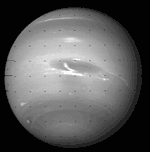Quick Links:
Sun, Moon, Mercury, Venus, Earth, Mars, Jupiter, Saturn, Uranus, Neptune, Pluto, More Planets, Comets
Neptune represents the universal ocean of oneness with all beings. It is thus highly compassionate, also idealistic, imaginative and self losing or even self undoing, and can be associated with drugs or media, as fantasy expressions. Neptune rules Pisces, and finds its exaltation in Cancer. Its position indicates where there may be confusion and also great creativity in poetic or musical fields. Neptune has been called the higher octave of Venus.

The ice giant Neptune was the first planet located through mathematical predictions rather than through regular observations of the sky. (Galileo had recorded it as a fixed star during observations with his small telescope in 1612 and 1613.) When Uranus didn't travel exactly as astronomers expected it to, a French mathematician, Urbain Joseph Le Verrier, proposed the position and mass of another as yet unknown planet that could cause the observed changes to Uranus' orbit. After being ignored by French astronomers, Le Verrier sent his predictions to Johann Gottfried Galle at the Berlin Observatory, who found Neptune on his first night of searching in 1846. Seventeen days later, its largest moon, Triton, was also discovered. Nearly 4.5 billion kilometers (2.8 billion miles) from the Sun, Neptune orbits the Sun once every 165 years. It is invisible to the naked eye because of its extreme distance from Earth. Interestingly, the unusual elliptical orbit of the dwarf planet Pluto brings Pluto inside Neptune's orbit for a 20-year period out of every 248 Earth years. Pluto can never crash into Neptune, though, because for every three laps Neptune takes around the Sun, Pluto makes two. This repeating pattern prevents close approaches of the two bodies.
| Planet | Mass (10x24 kg) | Volume (10x10 km3 | Equatorial radius (km) | Polar radius (km) | Mean density (kg/m3) | Surface gravity (m/s2) | Surface acceleration (m/s2) | Escape velocity (km/s) |
| Neptune | 102.43 | 6,254 | 24,764 | 24,341 | 1,638 | 11.15 | 11.00 | 23.5 |
| Earth | 5.9736 | 108.321 | 6378.1 | 6356.8 | 5515 | 9.80 | 9.78 | 11.2 |
| Name | Orbital Period | Sidereal rotation |
| Neptune | 164,9 Years | 16,11 Hours |
Discoverer: Johann Gottfried Galle
(based on predictions by John Couch Adams and Urbain Leverrier)
Discovery Date: 23 September 1846
Distance from Earth
Minimum (10x6 km) 4305.9
Maximum (10x6 km) 4687.3
Apparent diameter from Earth
Maximum (seconds of arc) 2.4
Minimum (seconds of arc) 2.2
Mean values at opposition from Earth
Distance from Earth (10x6 km) 4347.31
Apparent diameter (seconds of arc) 2.3
Apparent visual magnitude 7.8
Maximum apparent visual magnitude 7.78
Surface Pressure: >>1000 bars
Temperature at 1 bar: 72 K (-201 C)
Temperature at 0.1 bar: 55 K (-218 C)
Density at 1 bar: 0.45 kg/m3
Wind speeds: 0-200 m/s Scale height: 19.1 - 20.3 km
Mean molecular weight: 2.53 - 2.69 g/mole
Atmospheric composition (by volume, uncertainty in parentheses)
Major:
Molecular hydrogen (H2) - 80.0% (3.2%)
Helium (He) - 19.0% (3.2%)
Methane (CH4) 1.5% (0.5%)
Minor (ppm):
Hydrogen Deuteride (HD) - 192
Ethane (C2H6) - 1.5
Aerosols: Ammonia ice, water ice, ammonia hydrosulfide, methane ice
Technical Information courtesy of Nasa
Quick Links:
Sun, Moon, Mercury, Venus, Earth, Mars, Jupiter, Saturn, Uranus, Neptune, Pluto, More Planets, Comets